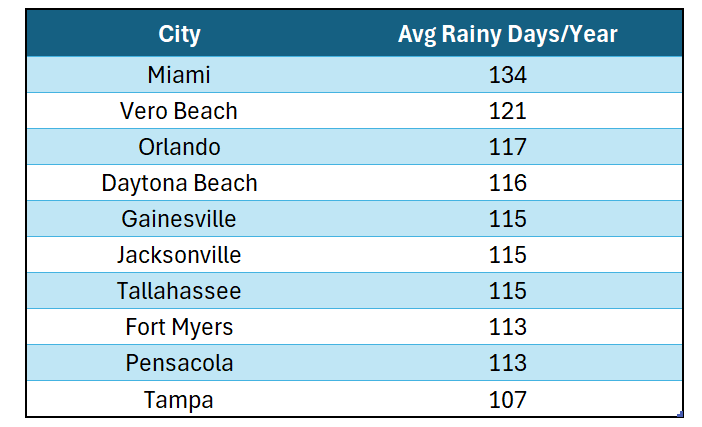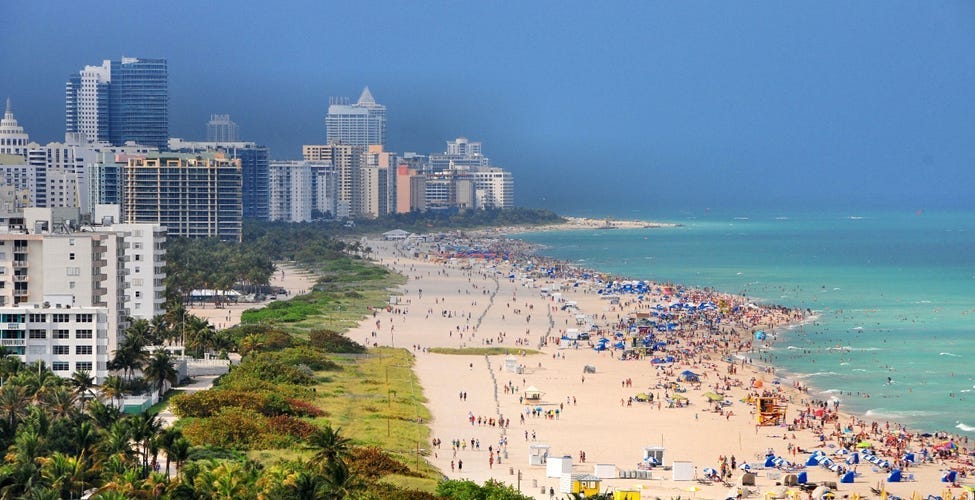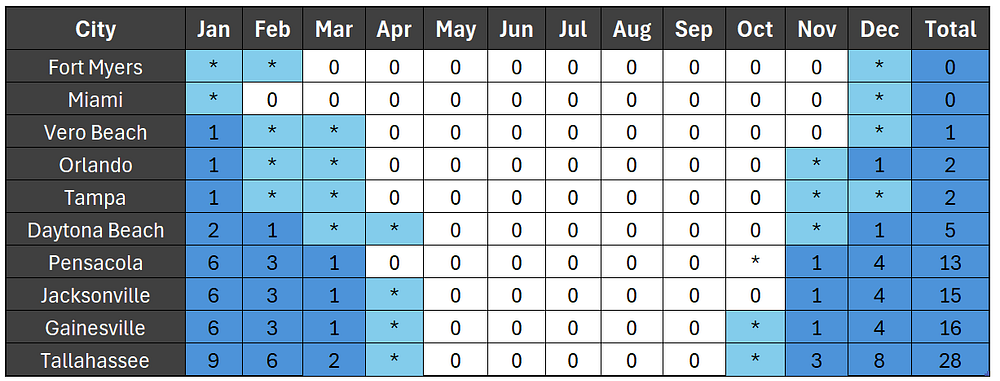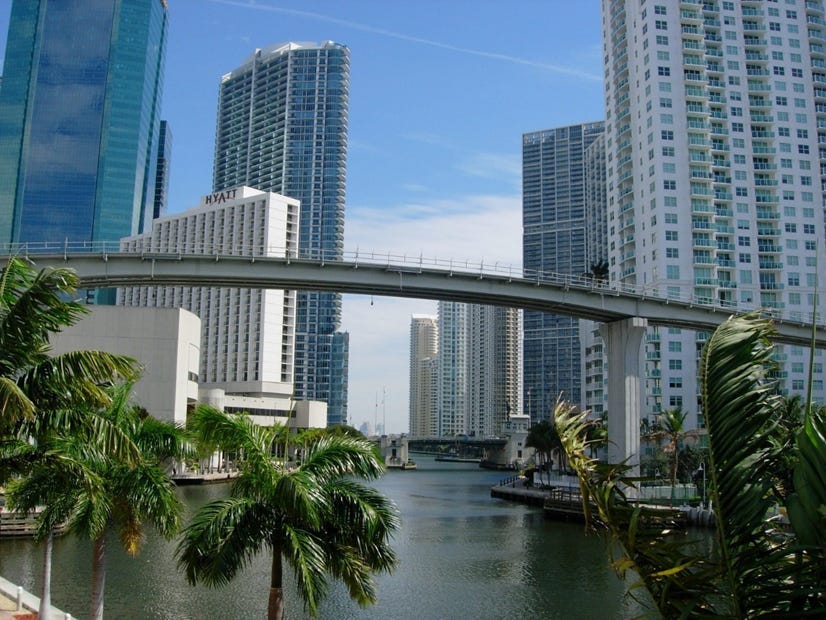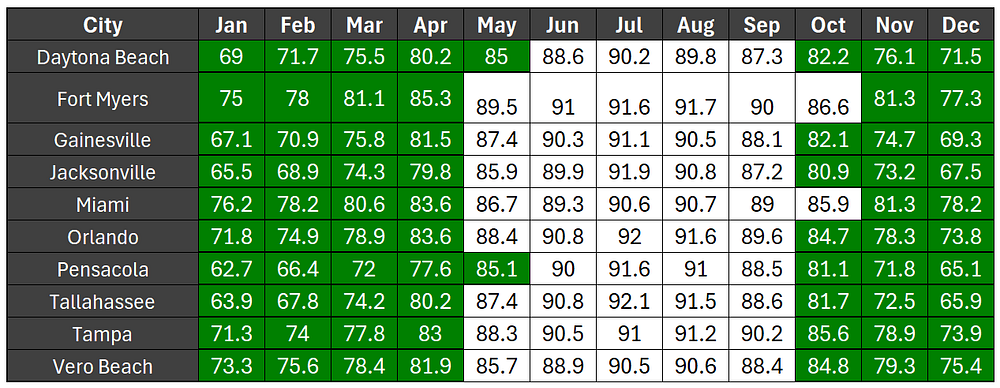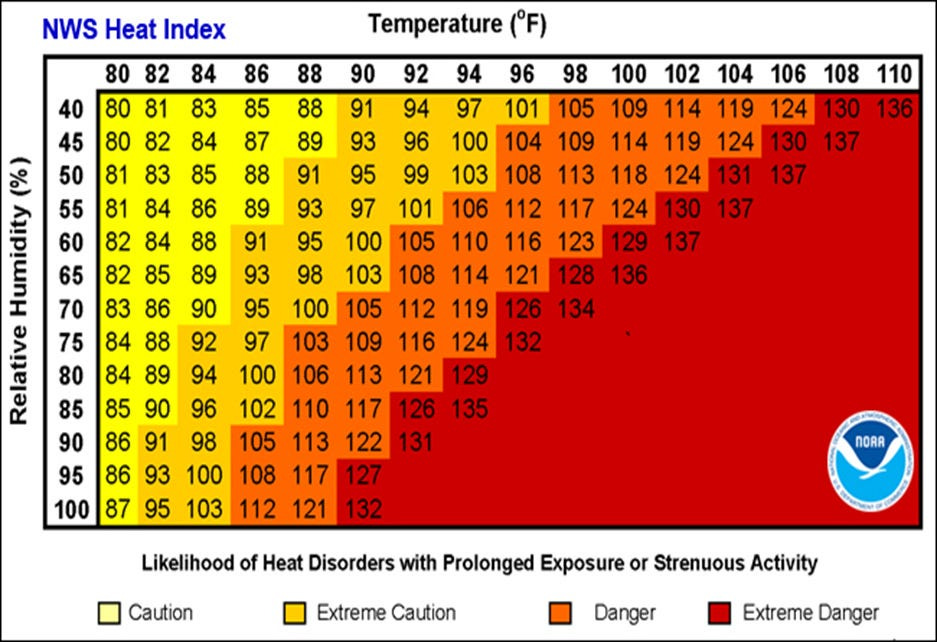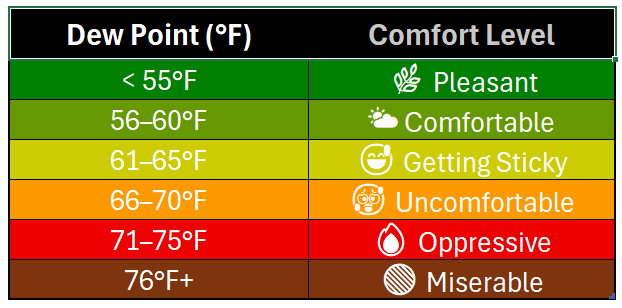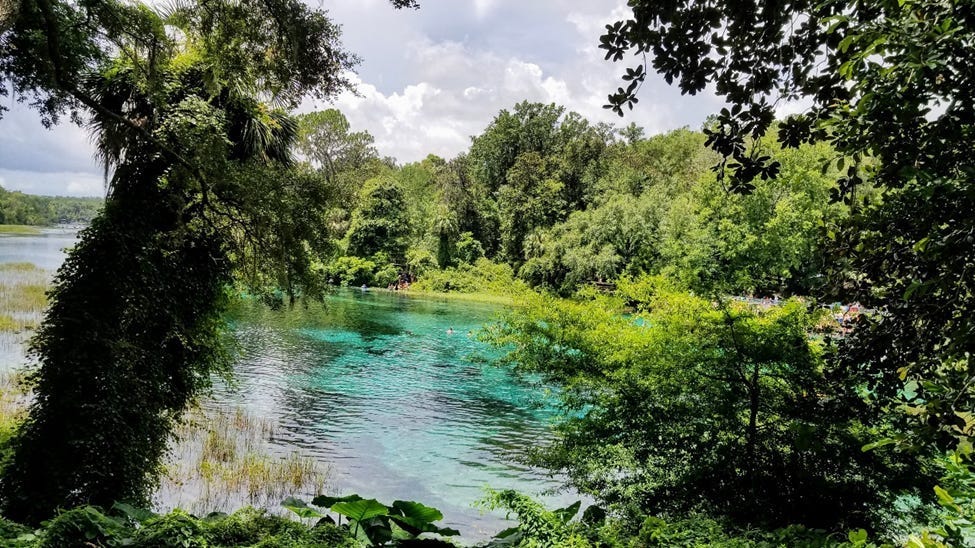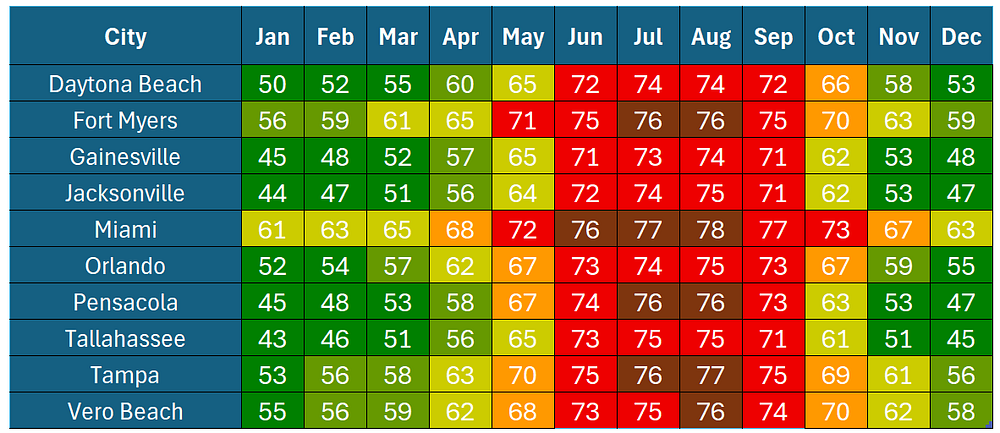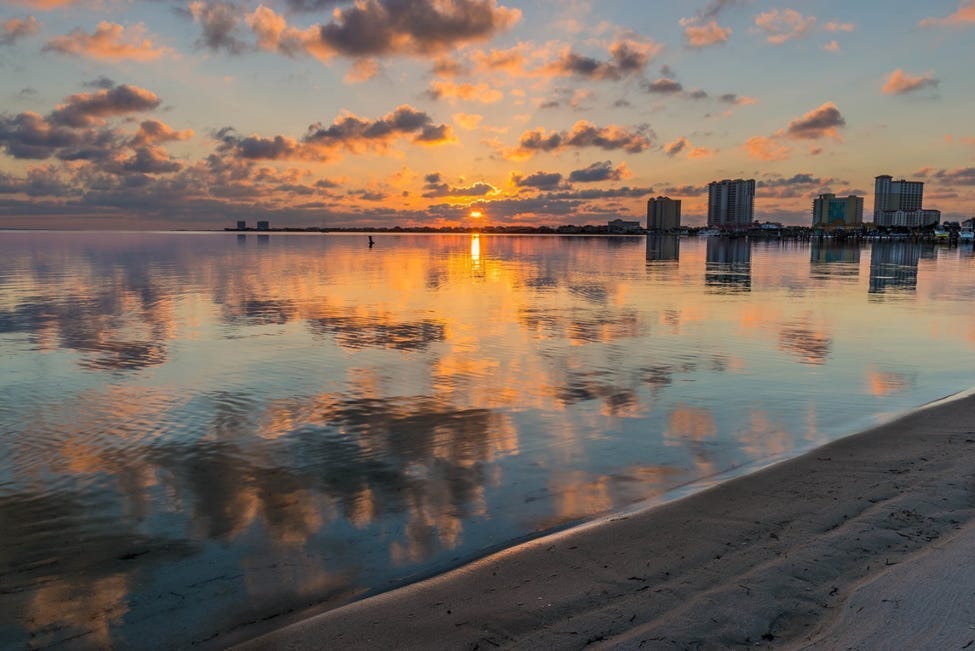Which part of Florida has the best climate year-round?
Which Florida city has the best climate year-round? Compare 10 cities using real NOAA data on heat, rain, dew points, and comfort to find out.
Which Florida city has the best climate year-round? I analyzed NOAA data from 10 cities — looking at rain, heat, freezes, and dew points to find out.
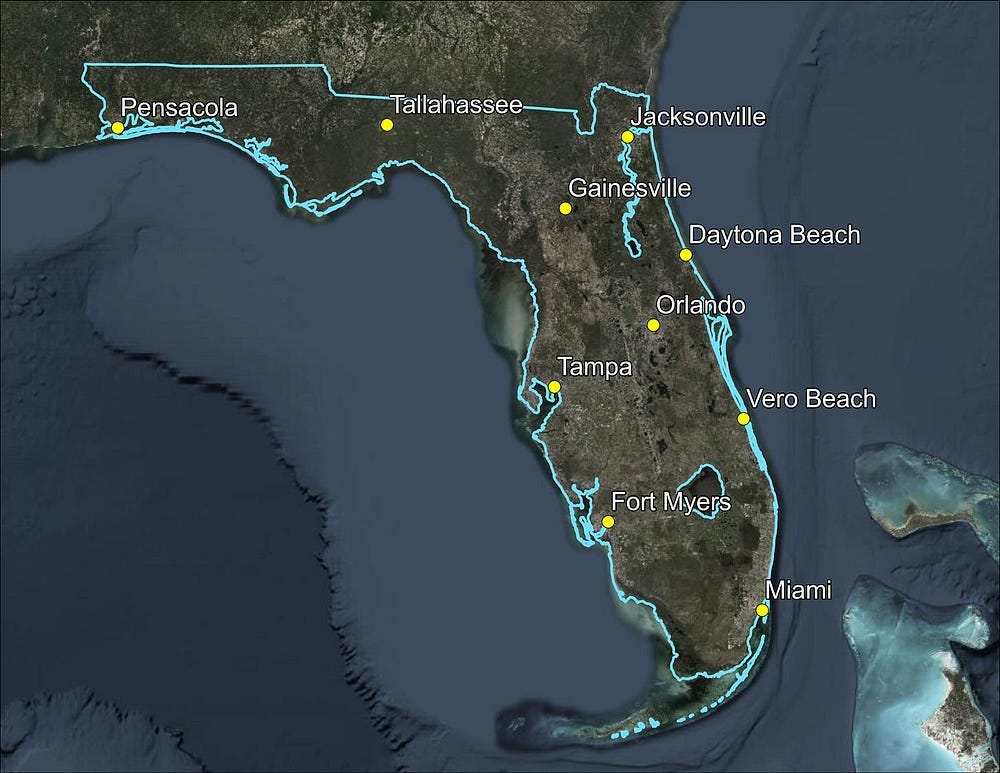
Florida’s Climate — and How I Compared Cities
The word “climate” comes from the Greek word klíma, meaning “slope” — a reminder that how we experience weather changes with location, especially with latitude and elevation.
I still remember as a kid, anytime we’d drive up into the mountains, it always felt cooler and fresher. There’s a simple reason for that: for every 330 feet you climb, the temperature usually drops by about 1°F. You don’t need a thermometer to notice it — your body feels the difference.
Florida is the opposite story. Almost the entire state is flat and low-lying, which means heat and humidity linger, especially in summer. Most of Florida falls into the humid subtropical zone, with tropical pockets in the far south and Keys. But those labels don’t always tell the full story.
Take Orlando and New York City — both technically “humid subtropical.” Yet in January, Orlando feels like a warm getaway while New York demands a heavy coat. That’s why I went beyond climate labels and turned to data to see which Florida city actually feels most comfortable year-round.
To figure out which part of Florida offers the most comfortable climate, I analyzed ten cities across the state using NOAA’s Comparative Climatic Data (CCD) from the cooler panhandle to the tropical south.
I scored each city on five factors: rainy days, freezing days, ideal days (66–85°F), hot days above 90°F, and dew point — the truest measure of sticky air.
Why dew point? Because in Florida, two 85°F days can feel completely different. Dew point explains why one day feels breezy and the next leaves you drenched.
Rainy Days
When it comes to rainy days, Tampa comes out on top with the fewest wet days each year — making them a solid pick for sunshine seekers. On the flip side, Miami ranks as the rainiest of the ten cities.
But don’t be fooled — rain in Florida often comes in quick bursts, especially in South Florida. Even in Miami, there’s still plenty of sunshine between the afternoon showers to hit the beach or enjoy the outdoors.
Freezing Days
As we can see from the table, it can freeze in Florida. Tallahassee is by far the coldest place among our ten cities with a whopping 28 days of freezing temperature.
Central Florida — home to cities like Orlando and Tampa — rarely experiences freezing temperatures, averaging fewer than two freeze days per year.
Even on the rare occasions when Central Florida dips below freezing, temperatures usually rebound quickly. By lunchtime, the sun is often shining and the air pleasantly mild again.
For those who do not wish to feel freezing temperature, South Florida with Miami and Fort Myers are the best places to avoid freezing temperatures, with less than half a day of freezing conditions on average.
Ideal Temperatures (66–85)
What’s the perfect temperature? That depends — just ask your family or coworkers during a thermostat tug-of-war. Most people agree that highs between 66°F and 85°F are ideal — warm enough to be outdoors, but not so hot that you rush for shade or AC
If we only looked at temperature alone, Pensacola and Daytona Beach would come out on top, with eight months of average highs falling in this ideal comfort range. That’s impressive.
But here’s the catch: temperature alone can be very misleading in Florida. A dry 85°F Day can feel perfectly fine, while a humid 85°F day — with a high dew point — can feel oppressive. That’s why I spent time earlier in this article highlighting dew point as a key comfort factor. It affects how the air really feels.
Rather than repeat the math by adjusting each temperature based on dew point, I’ll simply say this: higher dew points diminish comfort, especially in places like Fort Myers and Miami, where it often feels warmer than the thermometer suggests. This is why heat index — which combines temperature and dew point — is a better reflection of actual comfort
If you are curious NOAA heat index calculator is a great tool to explore how temperature and humidity combine to affect how it actually feels.
Best Overall Comfort: Daytona Beach and Pensacola.
Temperatures above 90 Degrees
Let’s now look at extreme heat. When temperatures rise above 90°F, outdoor activity becomes uncomfortable for most people — and potentially dangerous during prolonged exposure. According to NOAA, prolonged physical activities when the heat index is above 90 degrees can lead to heat stroke, heat cramps, or heat exhaustion.
Daytona Beach has the fewest days above 90°F, averaging just 60 per year.
Dew Points
Temperatures are obviously one of the main components to determine the best weather. However, temperatures can be deceiving as a high dew point can make 85 degrees feel like 91 degrees. According to NOAA, dew point is the temperature the air needs to be cooled to in order to achieve a relative humidity of 100%. The greater the dew point rises, the greater the amount of moisture in the air. Humidity alone doesn’t accurately reflect how the air will feel. As an illustration, 55 degrees with a 55 dew point is 100% humid. 80 degrees with 70 dew point gives us a 72% humidity. In this case, the humidity will feel greater at 72% vs the 100% humidity.
The following Dew Point categories can give us a quick indication on how it is going to feel outside:
I still remember when I first moved to Florida — I started sweating in places I never knew could sweat. The culprit? Dew points. The gold standard for comfort is a dew point below 55°F. Once it rises above 60°F, you start to feel sticky. And when it climbs above 71°F, even a short walk outside can leave you drenched.
Rainbow Springs, shown above, is one of many natural springs where Floridians can escape the heat — just dive into the crystal-clear, refreshing water that stays a cool 72°F year-round.
Tallahassee has by far the most comfortable dew point in Florida. From October through April, Tallahassee enjoys six months of comfortable dew points. Miami only has getting sticky dew point.
Conclusion
Pensacola emerges as the most balanced climate in Florida — offering pleasant afternoon temperatures for much of the year, moderate rainfall, lower dew points, and fewer extreme heat days. While it does experience a few more freezing mornings than South Florida cities, its overall comfort profile places it at the top of the list.
Daytona Beach comes in a close second. It enjoys mild winters with just over 4 freezing days per year (mostly brief overnight dips) and boasts a long stretch of ideal temperatures from October through mid-May. Its balance of low humidity and moderate heat makes it a standout for many.
Final Rankings: Best Overall Climate in Florida
Pensacola
Daytona Beach
Tampa
Gainesville
Vero Beach
Jacksonville
Tallahassee
Fort Myers
Orlando
Miami
Which City Is Best for You?
Sunshine Seekers: Tampa has the fewest rainy days.
Humidity Relief: Tallahassee stands out for having the lowest dew points during the cooler months.
Warm Winters: Miami and Fort Myers are your best bets to avoid freezes.
Ideal Daily Temperatures: Daytona Beach and Pensacola enjoy the most months in the comfort range of 66–85°F
Disclaimer: The views expressed in this article are solely my own and do not reflect those of any public agency, employer, or affiliated organization. This blog aims to educate and empower readers through objective geographic and planning insights, fostering informed discussion on global and regional issues.


